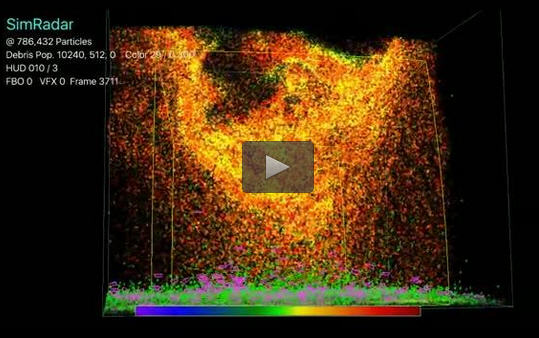Researchers develop radar simulator to characterize scattering of debris in tornadoes

Researchers use special simulations to study tornado debris and how it interacts with deadly tornadoes. Credit: NSF/OU
Researchers have developed the first numerical polarimetric radar simulator to study and characterize the scattering of debris particles in tornadoes. (See video)
The results of their study are published in the Institute of Electrical and Electronics Engineers (IEEE) journal Transactions on Geoscience and Remote Sensing.
“These results are important for operational weather forecasters and emergency managers,” says Nick Anderson, program director in the National Science Foundation's (NSF) Division of Atmospheric and Geospace Sciences, which funded the research. “An improved understanding of what weather radars tell us about tornado debris can help provide more accurate tornado warnings and quickly direct emergency personnel to affected areas.”
Current polarimetric radars, also called dual-polarization radars, transmit radio wave pulses horizontally and vertically. The pulses measure the horizontal and vertical dimensions of precipitation particles.
The radars provide estimates of rain and snow rates, accurate identification of the regions where rain transitions to snow during winter storms, and detection of large hail in summer thunderstorms.
But polarimetric radars have limitations the new research aims to address.
“With this simulator, we can explain in great detail to the operational weather community [weather forecasters] the tornadic echo from polarimetric radar,” says Robert Palmer, an atmospheric scientist at the University of Oklahoma (OU) and co-author of the paper. Palmer is also director of the university's Advanced Radar Research Center. “The knowledge gained from this study will improve tornado detection and near real-time damage estimates.”
Characterizing debris fields in tornadoes is vital, scientists say, because flying debris causes most tornado fatalities.
The researchers conducted controlled measurements of tornado debris to determine the scattering characteristics of several debris types, such as leaves, shingles and boards. The orientation of the debris, the scientists found, makes a difference in how it scatters and falls through the atmosphere — and where it lands.
###
Additional co-authors of the paper include OU's David Bodine, Boon Leng Cheong (lead author), Caleb Fulton, Sebastian Torres, and Takashi Maruyama of the Disaster Prevention Research Institute at Japan's Kyoto University.
The paper's co-authors designed the field experiments in collaboration with atmospheric scientist Howard Bluestein of OU.
Media Contact
All latest news from the category: Earth Sciences
Earth Sciences (also referred to as Geosciences), which deals with basic issues surrounding our planet, plays a vital role in the area of energy and raw materials supply.
Earth Sciences comprises subjects such as geology, geography, geological informatics, paleontology, mineralogy, petrography, crystallography, geophysics, geodesy, glaciology, cartography, photogrammetry, meteorology and seismology, early-warning systems, earthquake research and polar research.
Newest articles

Properties of new materials for microchips
… can now be measured well. Reseachers of Delft University of Technology demonstrated measuring performance properties of ultrathin silicon membranes. Making ever smaller and more powerful chips requires new ultrathin…

Floating solar’s potential
… to support sustainable development by addressing climate, water, and energy goals holistically. A new study published this week in Nature Energy raises the potential for floating solar photovoltaics (FPV)…

Skyrmions move at record speeds
… a step towards the computing of the future. An international research team led by scientists from the CNRS1 has discovered that the magnetic nanobubbles2 known as skyrmions can be…




















